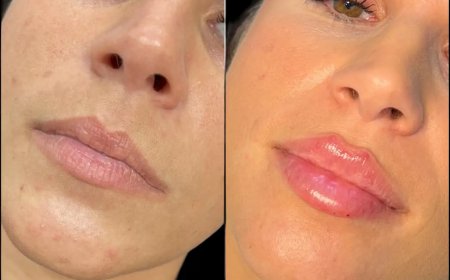Top Signs You Might Need to Visit a Skin Surgery Clinic
Our skin is our bodys largest organand its most visible. It acts as a protective barrier, regulates temperature, and gives us the outward appearance we often link to health and beauty. But when something feels offlike a suspicious mole, recurring cyst, or stubborn skin tagits easy to brush it aside as "just cosmetic" or "not urgent." Thats where the danger lies.
The truth is, certain skin concerns do require medical interventionand in some cases, surgical treatment. In this guide, well walk through the signs that suggest its time to stop Googling and start scheduling a consultation at a trusted clinic.
1. You Have a Changing Mole or Growth
One of the most common red flags is a mole that:
-
Changes in color or shape
-
Starts itching or bleeding
-
Becomes asymmetrical or raised
These signs can point to melanoma or other types of skin cancer. Early detection saves lives, and surgical removal is often the first line of treatment. A qualified dermatologist will likely biopsy the mole and, if needed, remove it entirely.
2. Youre Dealing with Cysts, Lipomas, or Unusual Lumps
Cysts are fluid-filled sacs, while lipomas are fatty tissue growths. Though often benign, they can become painful, infected, or increase in size over time. If a cyst bursts or a lipoma interferes with movement or comfort, surgery may be recommended.
Self-treatment (like trying to pop or squeeze them) can lead to scarring or infections. In contrast, surgical removal by an expert is clean, efficient, and minimizes damage to surrounding tissue.
3. Youve Been Told You Have Skin Cancer
This ones a no-brainer. A skin cancer diagnosis can be overwhelming, but not all cancers are aggressive. Basal cell carcinoma, squamous cell carcinoma, and melanoma all require different approachesbut surgery is often the most effective, especially if caught early.
Treatment may include excisional surgery, cryosurgery, or Mohs micrographic surgery, depending on the type and location.
4. Scars That Hurt, Itch, or Affect Movement
Not all scars are created equal. Some can become hypertrophic or keloidraised, red, and thick areas of tissue that grow beyond the wound's original borders. Others can pull on the skin, making it hard to move a limb or open your mouth fully.
In these cases, scar revision surgery can drastically improve appearance and function. An experienced skin surgeon can help reduce the scars visibility and restore flexibility.
5. Skin Tags or Warts That Wont Quit
While skin tags and warts are usually harmless, they can be uncomfortable, especially if they appear in friction-prone areas like the neck, underarms, or eyelids. Home remedies dont always workand in some cases, they can cause burns or scarring.
Professionally removing them at a skin surgery clinic ensures precise treatment with minimal damage.
6. Cosmetic Concerns That Affect Your Confidence
Sometimes, the reason isnt medicalits personal. You might want to remove a birthmark, minimize acne scars, or tighten sagging skin. Theres no shame in wanting to look your best and feel confident.
Modern dermatological surgery blends medical precision with aesthetic results. From laser resurfacing to surgical lifts, solutions are tailored to your needs and goals.
What to Expect During a Skin Surgery Consultation
Youre not signing up for surgery the moment you walk in. First, youll meet with a dermatologist who will:
-
Examine your skin
-
Ask about your medical history
-
Discuss treatment options
-
Outline possible risks and outcomes
A great clinic will never pressure you. Instead, theyll provide clarity, answer your questions, and help you feel empowered to make a decision.
Final Thoughts
Ignoring skin concerns rarely makes them go away. If you notice changes in moles, deal with recurring skin issues, or want cosmetic enhancements done safely, consult with a professional. Your skin deserves expert carebecause when you take care of your skin, you're also taking care of your overall health and confidence.
Article 2: How to Choose the Right Skin Surgery Clinic for Your Needs
With skin health becoming a top priority for many, more people are seeking surgical solutions for issues like skin cancer, scars, cysts, and cosmetic corrections. But here's the challengehow do you choose the right clinic for something so personal and medically sensitive?
Not every dermatologist or clinic is created equal. So before you let anyone near your skin with a scalpel or laser, lets walk through the checklist of how to find a trustworthy, skilled, and safe provider.
1. Check Credentials First
Always, always start with credentials. Look for:
-
Board-certified dermatologists or plastic surgeons
-
A license to operate as a medical facility
-
Experience in the specific procedure you're considering
A skilled provider should be transparent about their education, training, and past procedures. If a clinic downplays qualifications or avoids the question, walk away.
2. Look at the Technology They Use
A good clinic invests in advanced technology. Whether it's laser equipment, cryotherapy tools, or minimally invasive surgical instruments, their gear should be up-to-date and well-maintained. This not only ensures better results but also reduces the risk of complications.
Ask about:
-
Sterilization protocols
-
Tools for anesthesia and sedation
-
Post-op care equipment (dressings, gels, laser therapy, etc.)
3. Reputation MattersDo the Research
Check online reviews, testimonials, and before-and-after photos. Ask your primary doctor for referrals. If a friend or family member had a great experience, thats even better.
Look for consistent praise on things like:
-
Cleanliness of the clinic
-
Communication and bedside manner
-
Clear post-surgery instructions
-
Natural-looking results
A skin surgery clinic with a reputation for excellence will have satisfied patients willing to vouch for them.
4. Transparency Is a Must
You should never be left guessing. A reputable clinic will walk you through:
-
Treatment plans and alternatives
-
Costs and possible insurance coverage
-
Downtime and recovery
-
Risks, side effects, and success rates
Avoid places that use high-pressure sales tactics, overpromise results, or push you to book quickly. Real professionals earn your trust, not demand it.
5. Visit the Facility (If Possible)
If you're serious about booking a procedure, ask for a tour. Observe:
-
Cleanliness and organization
-
The demeanor of staff
-
How they treat walk-ins or waiting patients
-
Their approach to safety protocols
Even small detailslike labeled tools, gloves, and patient seatingcan offer insight into how seriously they take hygiene and professionalism.
6. Ask the Right Questions
Bring a list of questions to your consultation. Start with:
-
How many times have you performed this procedure?
-
What complications have you seen, and how are they handled?
-
Will I need local or general anesthesia?
-
Can I see before-and-after photos of similar cases?
Their answers will tell you not only their level of expertise but how much they value your comfort and understanding.
7. Pay Attention to Communication
Good communication builds confidence. A trustworthy clinic will:
-
Encourage you to ask questions
-
Follow up after the procedure
-
Offer multiple contact methods (phone, email, emergency line)
They'll also give clear aftercare instructions and make sure you understand every step of the process. If they seem rushed or vagueits a red flag.
Final Thoughts
Choosing a skin surgery provider isnt just about proximity or pricing. Its about trust, skill, and the level of care they offer. Whether you're tackling a medical concern or looking to enhance your appearance, never compromise when it comes to your skin.
Take the time to research, visit, and ask questions. Your skin deserves nothing less than the bestand the right clinic will make sure you get it.
Let me know if you'd like these articles formatted for a CMS like WordPress or if you'd prefer social snippets derived from each!


































